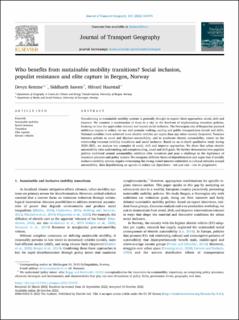Who benefits from sustainable mobility transitions? Social inclusion, populist resistance and elite capture in Bergen, Norway
Journal article, Peer reviewed
Published version

Åpne
Permanent lenke
https://hdl.handle.net/11250/3031983Utgivelsesdato
2022Metadata
Vis full innførselSamlinger
- Department of Geography [676]
- Registrations from Cristin [10402]
Sammendrag
Transitioning to sustainable mobility systems is generally thought to require three approaches: avoid, shift and improve. We examine a combination of these in a city at the forefront of implementing transition policies, focusing on how the approaches interact and impact social inclusion. The Norwegian city of Bergen has pursued ambitious targets to reduce car use and promote walking, cycling and public transportation (avoid and shift). National subsidies have achieved more electric vehicles per capita than any other country (improve). Tensions between policies to avoid and displace automobility, and to accelerate electric automobility, center on the relationship between mobility transitions and social inclusion. Based on an in-depth qualitative study during 2020–2021, we analyze key examples of avoid, shift and improve approaches. We show that urban electric automobility risks undermining, not complementing, avoid and shift goals. We further demonstrate how populist politics mobilized around automobility reinforce elite narratives and pose a challenge to the legitimacy of transition planners and policy makers. We recognize different forms of depoliticization and argue that if socially inclusive mobility systems require overcoming the strong vested interests embedded in cultural attitudes around automobility, then depoliticizing an agenda to reduce car dependence – not just cars – can be progressive.
